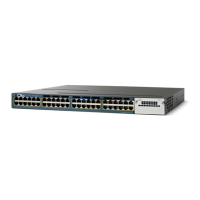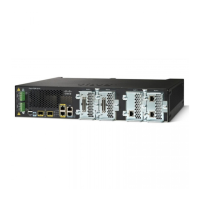24-4
Catalyst 3550 Multilayer Switch Software Configuration Guide
78-11194-09
Chapter 24 Configuring SPAN and RSPAN
Understanding SPAN and RSPAN
Some features that can cause a packet to be dropped during receive processing have no effect on
SPAN; the destination port receives a copy of the packet even if the actual incoming packet is
dropped. These features include IP standard and extended input access control lists (ACLs), IP
standard and extended output ACLs for unicast and ingress QoS policing.VLAN maps, ingress QoS
policing, and policy-based routing. Switch congestion that causes packets to be dropped also has no
effect on SPAN.
• Transmit (Tx) SPAN—The goal of transmit (or egress) SPAN is to monitor as much as possible all
the packets sent by the source interface after all modification and processing is performed by the
switch. A copy of each packet sent by the source is sent to the destination port for that SPAN session.
The copy is provided after the packet is modified.
Only one egress source port is allowed per SPAN session. VLAN monitoring is not supported in the
egress direction.
Packets that are modified because of routing—for example, with a time-to-live (TTL) or
MAC-address modification—are duplicated at the destination port. On packets that are modified
because of QoS, the modified packet might not have the same DSCP (IP packet) or CoS (non-IP
packet) as the SPAN source.
Some features that can cause a packet to be dropped during transmit processing might also affect the
duplicated copy for SPAN. These features include VLAN maps, IP standard and extended output
ACLs on multicast packets, and egress QoS policing. In the case of output ACLs, if the SPAN source
drops the packet, the SPAN destination would also drop the packet. In the case of egress QoS
policing, if the SPAN source drops the packet, the SPAN destination might not drop it. If the source
port is oversubscribed, the destination ports will have different dropping behavior.
• Both—In a SPAN session, you can monitor a single port for both received and sent packets.
Source Port
A source port (also called a monitored port) is a switched or routed port that you monitor for network
traffic analysis. In a single local SPAN session or RSPAN source session, you can monitor source port
traffic such as received (Rx), transmitted (Tx), or bidirectional (both); however, on a VLAN, you can
monitor only received traffic. The switch supports any number of source ports (up to the maximum
number of available ports on the switch) and any number of source ingress VLANs (up to the maximum
number of VLANs supported).
A source port has these characteristics:
• It can be any port type (for example, EtherChannel, Fast Ethernet, Gigabit Ethernet, and so forth).
• It can be monitored in multiple SPAN sessions.
• It cannot be a destination port.
• Each source port can be configured with a direction (ingress, egress, or both) to monitor. For
EtherChannel sources, the monitored direction would apply to all the physical ports in the group.
• Source ports can be in the same or different VLANs.
• For VLAN SPAN sources, all active ports in the source VLAN are included as source ports.
You can configure a trunk port as a source port. By default, all VLANs active on the trunk are monitored.
You can limit SPAN traffic monitoring on trunk source ports to specific VLANs by using VLAN
filtering. Only switched traffic in the selected VLANs is sent to the destination port. This feature affects
only traffic forwarded to the destination SPAN port and does not affect the switching of normal traffic.
This feature is not allowed in sessions with VLAN sources.

